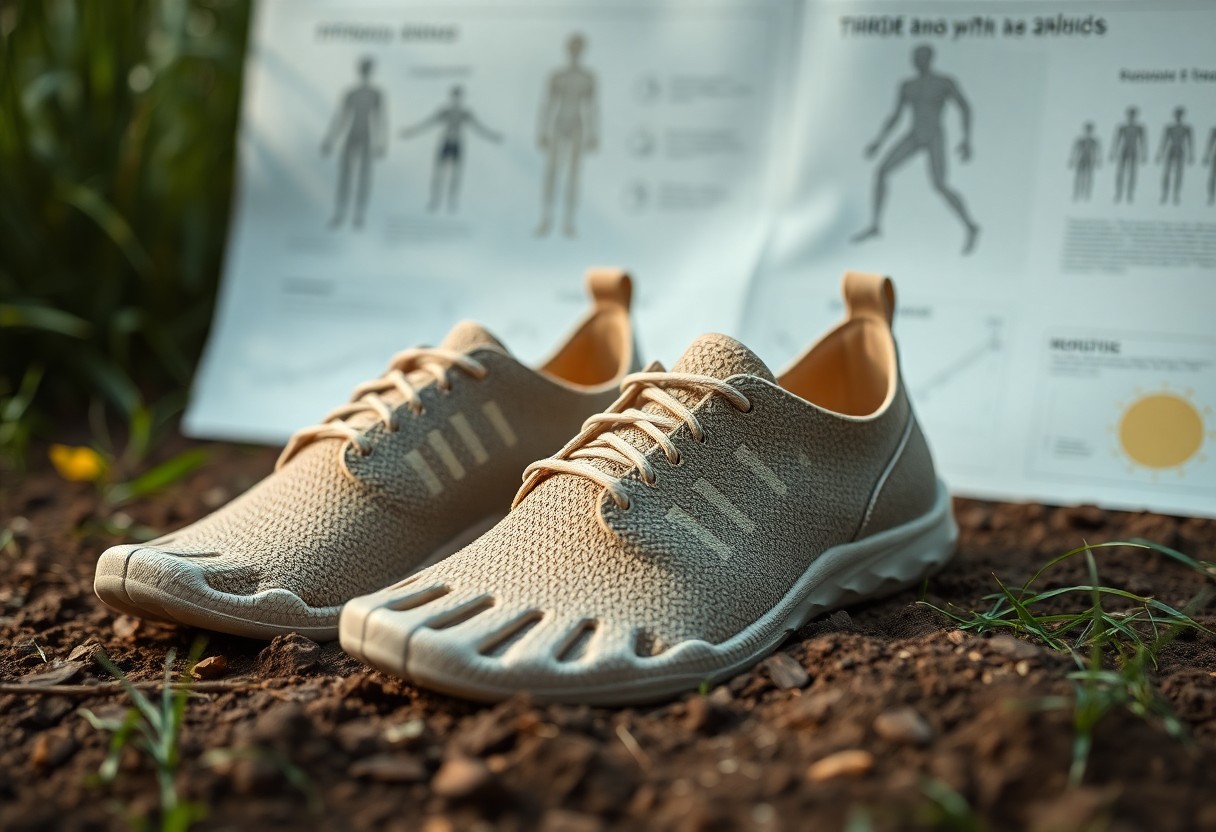Embracing sustainable design in footwear transcends the mere act of reducing waste; it profoundly enhances foot health as well. Barefoot shoes are at the forefront of a transformative movement within the industry, significantly lowering CO₂ emissions through the application of innovative materials and optimised manufacturing processes. By selecting these eco-friendly designs, you are actively participating in a vision for a future where biomechanical optimisation aligns seamlessly with environmental responsibility. Become part of the swelling movement towards footwear that not only nurtures your physical well-being but also protects our planet. Extensive lifecycle assessments reveal that minimalist shoe designs can substantially decrease your carbon footprint, yielding a positive effect on both personal health and the environment.
Revolutionising Footwear Production for Enhanced Environmental Sustainability
To genuinely redefine the production of footwear, it is imperative to adopt innovative strategies that effectively reduce the environmental footprint associated with this sector. The footwear industry is a significant contributor to global CO₂ emissions, which necessitates the adoption of sustainable practices that emphasise ecological balance and safeguard consumer health. By concentrating on advanced material sourcing, enhancing manufacturing efficiency, and establishing comprehensive end-of-life management strategies, the footwear industry can make notable strides towards minimising its carbon impact. This transition yields benefits not only for the environment but also aligns with the burgeoning consumer demand for responsible and sustainable products.
Leveraging Innovative Materials to Promote Sustainability
Pioneering brands are actively embracing disruptive material innovations to significantly reduce their environmental impact. For instance, Xero Shoes’ dedication to using materials like hemp and recycled PET has resulted in an impressive 32% reduction in production emissions, aligning with the increasing consumer demand for sustainable products. This strategic pivot not only protects local ecosystems but also fosters a circular economy by actively minimising waste throughout the production process. By prioritising these sustainable materials, brands enhance their environmental stewardship while appealing to a more conscientious consumer base.
Conducting Comprehensive Lifecycles Analysis to Uncover Carbon Footprint Reductions
Performing thorough lifecycle analysis is crucial for accurately assessing the overall carbon footprint of footwear products. By scrutinising each phase—from material sourcing and production to usage and eventual disposal—you can identify key areas that require enhancement. For example, the typical emissions associated with barefoot shoes range between 10-20 kg CO₂e per pair, marking a remarkable 40% decrease compared to traditional athletic footwear. Initiatives such as Vivobarefoot’s ReVivo programme, which extends the lifespan of shoes and reduces emissions to just 5.8 kg CO₂e, underscore the considerable advantages that sustainability measures can yield regarding production efficiency and consumer appeal.
Boosting Foot Health through Biomechanics and Barefoot Shoe Design
The integration of biomechanics into the design of barefoot shoes amplifies the myriad benefits associated with minimalist footwear, leading to notable enhancements in both foot health and sustainability. By prioritising natural foot movement, these shoes allow your feet to function as they were designed to, resulting in improved posture and a decreased risk of injuries. The lightweight construction of barefoot shoes also promotes a more efficient gait, making each step feel more comfortable and less taxing on your body. This not only contributes to your personal well-being but also aligns with a commitment to ecological sustainability, as every step taken in these shoes supports both health and environmental integrity.
How Minimalist Designs Enhance Gait and Movement Optimisation
Minimalist designs found in barefoot shoes encourage a natural gait that favours midfoot or forefoot striking patterns. This alteration can significantly diminish the impact force on your joints, resulting in a more efficient and enjoyable walking or running experience. By eliminating excessive cushioning and support, these shoes enable your foot muscles to engage fully, thereby strengthening the intrinsic musculature necessary for optimal movement. This natural approach to footwear not only boosts your physical performance but also fosters an enhanced connection with the ground, enriching your overall physical activity and experience.
Exploring Energy Efficiency in Movement: Scientific Insights
Recent scientific investigations underscore the vital importance of energy efficiency in the performance of barefoot shoes. Research reveals that runners donning barefoot footwear experience a remarkable enhancement in energy return and propulsion mechanics, translating to less fatigue and a more sustainable running style. This directly enhances your movement efficiency during extended activities, rendering each step more productive. Superior energy efficiency is deeply rooted in the thoughtful design of barefoot shoes, which support improved biomechanics. For instance, trials involving 15 participants demonstrated that those wearing minimalist shoes crafted from algae-foam materials reported an energy return rate of 89% compared to a mere 82% for conventional EVA foams. This dynamic characteristic of barefoot footwear allows for a more natural range of motion, significantly alleviating knee stress during various activities. By harnessing these benefits, barefoot shoes emerge not only as an environmentally conscious choice but also as a cutting-edge solution for achieving optimal energy efficiency in motion.

Understanding Consumer Trends: The Growing Demand for Sustainable Footwear
Grasping consumer motivations is essential for nurturing the widespread adoption of sustainable footwear. Modern buyers are increasingly prioritising ecological and health benefits, gravitating towards products that meet their functional needs while also aligning with their values related to environmental responsibility and holistic well-being. As awareness of sustainability escalates, consumers are actively seeking footwear brands that embody these principles and practices.
Identifying Eco-Conscious Consumer Trends and Preferences
As sustainability solidifies itself as a core value, eco-conscious consumers are actively searching for footwear brands that reflect these ideals. Recent statistics indicate that 43% of shoppers are willing to pay a premium of 30% for sustainably produced shoes, illustrating a significant shift in consumer priorities towards eco-friendly materials and practices. This trend highlights the increasing significance of sustainability as a key factor in purchasing decisions, motivating brands to embrace more responsible production methods.
Comprehending the Perceived Value of Sustainability in Footwear
The perception of value surrounding sustainability in footwear is not merely a fleeting trend; it constitutes a fundamental aspect of purchasing decisions. As a consumer, factors such as environmental concerns, health benefits, and durability guarantees are likely to influence your choices, with research indicating that perceived environmental benefits rank highest among consumer motivations. By opting for sustainable footwear, you are supporting a broader movement towards responsible consumption, which resonates with many buyers today.
This growing awareness of environmental impact indicates that consumers appreciate brands that prioritise sustainable features. Such perceptions of value foster stronger brand loyalty and can amplify the effect of your purchasing decisions, incentivising manufacturers to invest in greener practices and materials. Ultimately, sustainability enhances the perceived worth of a product, aligning your choices with larger environmental objectives while effectively fulfilling your footwear requirements.
Navigating the Evolving Regulatory Landscape for Sustainable Footwear Innovation
The continuously changing regulatory landscape plays a pivotal role in steering the footwear industry towards sustainable innovation. With heightened scrutiny on carbon emissions and environmental degradation, new regulations are being introduced to promote greener practices within manufacturing processes. Complying with these emerging mandates not only addresses urgent environmental issues but also aligns with consumer expectations, compelling brands to innovate responsibly and transparently while adhering to compliance standards.
Understanding Compliance Mandates: Catalysing Sustainable Practices
Emerging compliance mandates, particularly within the European Union, are establishing a foundation for sustainable practices throughout the footwear industry. By 2027, regulations will necessitate a minimum of 20% recycled content in footwear materials, while by 2026, carbon labelling will become mandatory for all athletic shoes. These guidelines compel brands to rethink their material sourcing, production processes, and end-of-life strategies, ensuring greater accountability and environmental stewardship within the sector.
Harnessing Innovation Through Regulation: Opportunities and Challenges
While new regulations pose various challenges, they simultaneously unlock innovative opportunities for brands willing to adapt. Embracing compliance mandates encourages companies to invest in sustainable technologies, developing solutions that reduce carbon footprints while enhancing overall product performance. For example, brands are exploring biodegradable materials and advanced manufacturing techniques that can result in improved durability and reduced waste. However, navigating the complexities of regulatory compliance necessitates a flexible approach, as organisations must balance sustainability objectives with market demands and cost considerations.
In light of these challenges, the regulatory landscape fosters a culture of innovation that promotes the development of new materials and processes. Embracing technologies such as 3D printing and biobased materials not only complies with regulatory requirements but also offers unique branding opportunities that resonate with environmentally conscious consumers. Brands that are prepared to embrace these transformative changes will distinguish themselves in a competitive market, driving progress while adhering to stringent environmental standards. By perceiving regulation as an opportunity rather than a barrier, you can position your brand at the forefront of the sustainable footwear movement.
Imagining the Future of Footwear: The Intersection of Technology and Sustainability
The fusion of technology and sustainability is revolutionising the footwear industry as we know it. Manufacturers are harnessing advanced materials and incorporating intelligent features, paving the way for the next generation of shoes that promise enhanced performance while simultaneously minimising environmental impact. Innovations such as 3D printing and smart systems are creating designs that not only cater to your foot health needs but also uphold ecological integrity. This dynamic shift reflects a deepening commitment to merging functionality with environmental responsibility in the footwear sector.
Integrating Smart Features into Footwear: Elevating User Experience and Ecological Benefits
Smart features in footwear significantly enrich your experience while contributing to sustainability objectives. By incorporating sensors, these shoes can offer real-time feedback on your gait, enabling you to optimise your performance and effectively minimise injury risks. Furthermore, these innovations frequently utilise eco-friendly materials, ensuring that your athletic pursuits harmoniously align with your commitment to protecting the environment.
On-Demand Production: Customisation and the Role of 3D Printing in Sustainable Footwear
On-demand production leverages 3D printing technology to create shoes specifically tailored to meet your individual requirements. This innovative approach not only facilitates a customised fit but also significantly curtails the waste generated by traditional manufacturing methods. By employing cutting-edge 3D printing techniques, brands can produce footwear that accurately reflects individual foot dimensions based on pressure mapping and other biometric data. This degree of customisation diminishes the likelihood of returns and excess inventory, with studies indicating a 73% reduction in waste through on-demand manufacturing practices. Moreover, localised production reduces transportation emissions and bolsters regional economies. As brands embrace this technology, you gain access to shoes that are not only better suited to your feet but also more environmentally responsible.
Your Contribution to the Sustainable Footwear Movement
In essence, the innovative strides in sustainable footwear are reshaping the industry by harmonising biomechanics with environmental responsibility in barefoot shoe design. By incorporating minimalist footwear into your daily life, you can enhance your foot health while making a significant impact on your carbon footprint. Selecting shoes that prioritise sustainable materials and ethical manufacturing practices supports a transformative shift towards a more eco-conscious market. Embracing these advancements not only benefits you personally but also contributes to the overarching objective of planetary well-being, advocating for a future where functionality and sustainability coexist harmoniously.
The Article Sustainable Footwear Innovation: Bridging Biomechanics and Environmental Responsibility in Barefoot Shoe Design appeared first on My Shoes Finder
The Article Sustainable Footwear Innovation in Eco-Friendly Barefoot Design Was Found On https://limitsofstrategy.com








